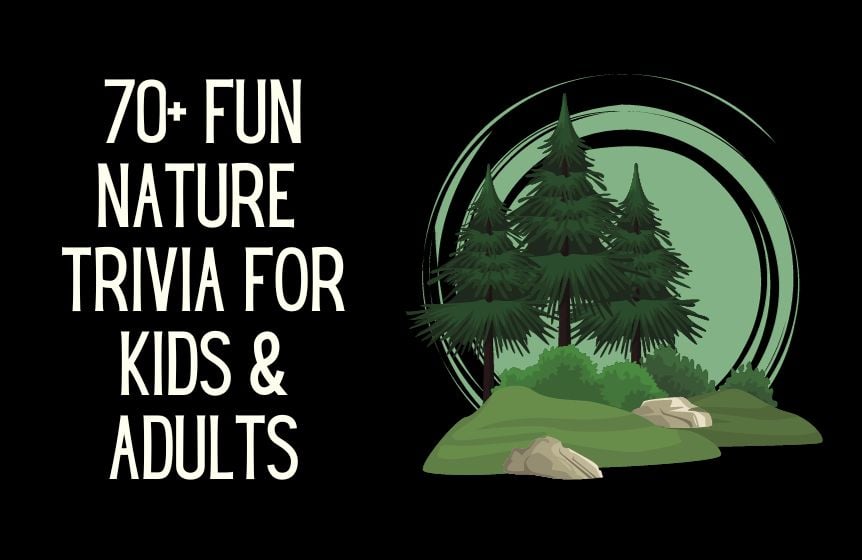Welcome to the wonderful world of nature trivia! Whether you’re an avid nature enthusiast or just looking to test your nature knowledge, this article has something for everyone. From fun facts for kids to challenging questions for seniors, let’s embark on a journey through the diverse and fascinating realm of the natural world. So, grab your trivia cards and get ready for some spontaneous trivia sessions!

Nature Trivia for Kids
- What is the tallest mountain in the world? Mount Everest
- What is the only fruit with seeds on the outside? Strawberry
- Which planet is known as the Red Planet? Mars
- What type of animal is a polar bear? Marine mammal
- What is the largest species of shark? Whale shark
- What is the name of the star that is closest to Earth? The Sun
- Which planet in our solar system is known for its rings? Saturn
- What type of animal is the blue whale? Marine mammal
- Which animal is known for carrying its home on its back? Tortoise
- What is the name of the gas that plants produce during photosynthesis? Oxygen
- What is the largest mammal on land? African elephant
- Which bird is known for its beautiful tail feathers and dance? Peacock
- What is the collective name for a group of lions? A pride
- Which animal is known as the “ship of the desert”? Camel
- What type of celestial body orbits planets? Moons
- Which animal is known to change its color to blend in with its surroundings? Chameleon
- What is the name of the Earth’s natural satellite? Moon
- Which animal is known for having a pouch to carry its young? Kangaroo
- What is the name of the process by which water turns into clouds? Evaporation
- Which insect is known for its ability to light up in the dark? Firefly
- What is the name of the colorful arc that appears in the sky after rain? Rainbow
Related : Fall trivia

Easy Nature Trivia Questions and Answers:
- Which mountain chain spans across North America? The Rocky Mountains
- What is the scientific name for the process plants use to make food from sunlight? Photosynthesis
- Which is the longest river in the world? The Nile River
- What is the most abundant element in the Earth’s atmosphere? Nitrogen
- Which animal is known as the “king of the jungle”? Lion
- What is the largest planet in our solar system? Jupiter
- Which bird is known for its ability to mimic sounds? Lyrebird
- What is the primary source of energy for plants? Sunlight
- Which continent is home to the Sahara Desert? Africa
- What is the name given to the study of plants? Botany
- Which animal is known for its unique black and white stripes? Zebra
- What is the largest mammal in the world? Blue whale
- Which tree is known to shed its bark annually? Eucalyptus
- What is the smallest ocean in the world? Arctic Ocean
- Which insect is known for its transformative life cycle from a caterpillar to a butterfly? Butterfly
- What is the primary gas responsible for the greenhouse effect? Carbon dioxide
- Which planet is known as the “blue planet” due to its appearance from space? Earth
- What is the name of the world’s largest coral reef system? The Great Barrier Reef
- Which animal is known to spend almost its entire life in the air, landing only to nest? Albatross
- What is the name of the process by which water vapor changes into liquid water? Condensation

Wild Nature Trivia Questions and Answers:
- Which bird holds the record for the longest migratory journey, traveling from the Arctic to Antarctica? The Arctic tern.
- What is the world’s most venomous fish? The stonefish.
- Which mammal holds the title for the deepest and longest dive, plunging to depths of over 10,000 feet? The sperm whale.
- In which continent would you find the Gobi Desert? Asia.
- What is the world’s largest living structure, visible from space? The Great Barrier Reef.
- Which big cat is recognized as the fastest land animal, capable of reaching speeds up to 60-70 mph? The cheetah.
- Which nocturnal primate, found in Southeast Asia, is known for its large, unblinking eyes? The tarsier.
- What is the name of the world’s smallest ocean? The Arctic Ocean.
- Which carnivorous plant is known for “snapping” shut to capture its prey? The Venus flytrap.
- The Komodo dragon, the world’s largest lizard, is native to which country? Indonesia.
- Which African animal is known as the “river horse”? The hippopotamus.
- What is the tallest waterfall in the world? Angel Falls in Venezuela.
- Which bird is known for its elaborate courtship dance, involving the spreading of its long tail feathers? The peacock.
- The capybara, the world’s largest rodent, is native to which continent? South America.
- Which marine creature has the ability to regenerate lost arms and even parts of its central disc? The starfish or sea star.
- In which forest would you find the majority of the world’s remaining mountain gorillas? The Bwindi Impenetrable Forest in Uganda.
- Which desert is the driest place on Earth, receiving only 0.6 inches of rain per year? The Atacama Desert in Chile.
- The narwhal, often referred to as the “unicorn of the sea,” is known for its long spiral tusk. But what is this tusk actually? A tooth.
- Which bird, native to Central and South America, is known for its ability to rotate its head nearly 270 degrees? The owl.
- The axolotl, a type of salamander that remains aquatic its entire life, is native to which country? Mexico.
UK Nature Quiz: Discover the Natural Wonders of the British Isles
The United Kingdom, comprising England, Scotland, Wales, and Northern Ireland, is a land rich in natural beauty and biodiversity. From its rugged coastlines and ancient woodlands to its majestic mountains and serene lakes, the UK is a haven for nature enthusiasts.
This quiz is dedicated to the unique flora, fauna, and natural landmarks that make the British Isles a remarkable place for nature lovers. How well do you know the natural wonders of the UK? Let’s find out!
- Which mountain is the highest peak in the British Isles? Ben Nevis.
- The Lake District, known for its picturesque lakes and fells, is located in which English county? Cumbria.
- Which bird, known for its distinctive call, is considered a symbol of the UK’s heathlands and moorlands? The curlew.
- The Giant’s Causeway, a UNESCO World Heritage site, is located in which part of the UK? Northern Ireland.
- Which tree is known as the national tree of England? The oak tree.
- Dartmoor and Exmoor are two national parks located in which region of England? South West England.
- Which large deer species, native to Scotland, is known for its impressive antlers? The red deer.
- The Pennines, often referred to as the “backbone of England,” are a range of what? Mountains and hills.
- Which coastal bird, known for its colorful bill, breeds on cliffs and islands around the UK? The puffin.
- Snowdonia National Park is located in which part of the UK? Wales.
- Which river is the longest in the UK? The River Severn.
- The Broads, a network of rivers and lakes, are found in which English county? Norfolk.
- Which island, located off the southern coast of England, is known for its white chalk cliffs? The Isle of Wight.
- The Scottish Highlands are home to which elusive lake-dwelling monster, according to folklore? The Loch Ness Monster or Nessie.
- Which flower, known for its blue petals, is considered the national flower of Scotland? The thistle.
- The New Forest, known for its ancient woodlands and wild ponies, is located in which English county? Hampshire.
- Which bird of prey, once extinct in England but reintroduced, can now be seen in the Lake District and parts of Scotland? The osprey.
- Hadrian’s Wall, an ancient Roman fortification, stretches across which part of the UK? Northern England.
- Which coastal feature in Dorset is known for its unique limestone arch? Durdle Door.
- The Brecon Beacons is a mountain range located in which part of the UK? Wales.
- Which Scottish island group is known for its prehistoric village, Skara Brae? The Orkney Islands.
- In which UK city can you find the Royal Botanic Gardens, a world-renowned center for plant research? Edinburgh.
- Which bird, with a distinctive red chest, is often associated with Christmas in the UK? The robin.
- The Fens, a naturally marshy region, is located in which part of England? Eastern England.
- Which large, freshwater lake is the largest by surface area in the British Isles? Lough Neagh in Northern Ireland.
- Which coastal region in Cornwall is known for its ecological importance and is a designated Area of Outstanding Natural Beauty? The Lizard Peninsula.
- The Cairngorms, a mountain range in Scotland, is home to how many of the UK’s highest peaks? Five.
- Which flower, characterized by its yellow petals, is the national flower of Wales? The daffodil.
- The Peak District, the first national park in the UK, is located in which region of England? Central England.
- Which rare butterfly, with large orange wings, can be found in some parts of the UK, particularly in woodland clearings? The silver-washed fritillary.
- Which chalk headland, located in East Sussex, offers stunning views of the English Channel? Beachy Head.
- The Wye Valley, known for its scenic river and surrounding landscape, borders England and which other UK country? Wales.
- Which marine bird, known for its black and white appearance and deep diving abilities, is commonly found on the coasts of Northern Scotland? The guillemot.
- The Mendip Hills, known for their limestone formations, are located in which English county? Somerset.
- Which large estuary, located on the east coast of Great Britain, is one of the major estuaries in the UK? The Humber Estuary.
- The Burren, known for its unique karst landscape and diverse flora, is located in which part of the UK? It’s a trick question; The Burren is in Ireland, not the UK.
- Which bird, known for its haunting call and nocturnal habits, is often associated with folklore and superstition in the UK? The barn owl.
- The Malvern Hills, known for their natural mineral springs, are located in which English county? Worcestershire.
- Which marine creature, characterized by its five arms and ability to regenerate, can be found along the UK’s coastlines? Starfish or sea star.
- The Shetland Islands, located to the northeast of mainland Scotland, are known for their native breed of which domesticated animal? Shetland pony.
The UK’s natural beauty is vast and varied, offering endless opportunities for exploration and discovery. Whether you’re trekking through the highlands or strolling along the coast, the British Isles are a treasure trove of natural wonders. Keep your spirit of adventure alive and continue to explore the many facets of the UK’s natural world!
Science Nature Trivia Questions and Answers:
- What is the chemical element with the symbol ‘O’ and atomic number 8? Oxygen.
- Which planet in our solar system is known for its Great Red Spot, a massive storm? Jupiter.
- What is the process by which plants convert carbon dioxide into glucose using sunlight? Photosynthesis.
- Which particle, found in the nucleus of an atom, carries a positive charge? Proton.
- What is the name of the galaxy in which our solar system resides? The Milky Way.
- Which phase of matter has a definite shape and volume? Solid.
- What is the most common gas found in the Earth’s atmosphere? Nitrogen.
- In the periodic table, which element is represented by the symbol ‘Au’? Gold.
- What is the scientific study of celestial objects, space, and the universe called? Astronomy.
- Which force, described by Sir Isaac Newton, explains why objects fall towards the Earth? Gravity.
- What is the name of the process by which a liquid turns into a gas? Evaporation.
- Which organ in the human body is responsible for filtering blood and removing waste products? The kidneys.
- What is the smallest unit of life, often called the building block of life? Cell.
- Which planet is often referred to as the “Evening Star” when visible from Earth? Venus.
- In genetics, what does DNA stand for? Deoxyribonucleic acid.
- What is the name of the force that holds atoms together in a molecule? Chemical bond.
- Which celestial event occurs when the moon passes between the Earth and the sun, blocking all or part of the sun’s light? Solar eclipse.
- What is the scientific name for the study of living organisms and their interactions with the environment? Ecology.
- Which subatomic particle, found outside the nucleus of an atom, carries a negative charge? Electron.
- What is the name of the branch of biology that deals with the study of heredity and variation in organisms? Genetics.
30 Fun Nature Trivia Facts
- Chatty Trees: Trees can “communicate” with each other through a network of mycorrhizal fungi in their root systems, often dubbed the “Wood Wide Web.”
- Banana Berries: Bananas are technically berries, while strawberries are not!
- Nature’s Clock: Some flowers, like the morning glory, open at specific times of the day.
- Floating Fire: Some seeds, like those of the eucalyptus tree, only germinate after experiencing a forest fire.
- Penguin Stones: Penguins give pebbles as “gifts” during courtship.
- Dancing Bees: Bees perform a “waggle dance” to communicate the location of food sources to other bees.
- Nature’s Flashlight: Fireflies produce light without heat in a process called bioluminescence.
- Desert Bloom: The Atacama Desert, one of the driest places on Earth, experiences a rare bloom of flowers after heavy rainfall.
- Magnetic Birds: Some birds can detect the Earth’s magnetic field and use it for navigation.
- Nature’s Skyscrapers: The tallest trees in the world, the redwoods, can grow over 350 feet tall.
- Underwater Forests: Kelp forests, found in oceans, can grow up to 18 inches in a single day.
- Nature’s Vacuum: Elephants can smell water from up to 3 miles away.
- Singing Sands: Some sand dunes “sing” or “hum” when the wind passes over them.
- Rainbow Eucalyptus: The rainbow eucalyptus tree sheds its bark in patches, revealing a spectrum of colors.
- Nature’s Compass: Sunflowers track the sun’s movement, a phenomenon called heliotropism.
- Glowing Waves: Some beaches have bioluminescent plankton that make the waves glow at night.
- Nature’s Parachute: Dandelion seeds can travel up to 5 miles from their origin.
- Star-nosed Talent: The star-nosed mole can eat faster than the human eye can follow – in just 227 milliseconds!
- Nature’s Music: Crickets’ chirps can be used to determine the temperature. Count the number of chirps in 14 seconds and add 40 to get the temperature in Fahrenheit.
- Floating Wonders: Some spiders can “fly” using silk strands to catch the wind, a phenomenon called ballooning.
- Nature’s Paintbrush: Butterflies taste with their feet.
- Laughing Foxes: Red foxes make a sound that’s similar to human laughter when they’re excited.
- Nature’s Elevator: Some species of fish, like the wrasse, use jellyfish to hitch a ride on ocean currents.
- Moonlit Blooms: The night-blooming cereus cactus flowers only bloom at night and wilt by dawn.
- Nature’s Trickster: The mimic octopus can imitate the appearance and behaviors of other marine animals.
- Glowing Mushrooms: Some mushrooms, like the bioluminescent Mycena, glow in the dark.
- Nature’s Jumper: Fleas can jump up to 200 times their body length.
- Sneezing Plants: When touched, the touch-me-not plant’s seed pods burst open, scattering seeds.
- Nature’s Velcro: The idea for Velcro came from the tiny hooks found on the surface of burrs.
- Dancing Plants: The “dancing” plant, or Desmodium gyrans, has leaves that move around in jerky motions throughout the day.
Senior Nature Exploration Facts and Queries:
- Approximately 71% of the Earth’s surface is covered by what? Water.
- “Terra” is the Latin word for what? Earth.
- Which breed of dog is known for its distinctive blue-black tongue? Chow Chow.
- Which plant, often found in North America, is known to cause an itchy rash upon contact? Poison ivy.
- What is a male swan called? Cob.
- Windmills, tulips, and canals are iconic symbols of which European country? The Netherlands.
- Who is the famous naturalist known for his theory of evolution and the book “On the Origin of Species”? Charles Darwin.
- Native to the coasts of the northern and eastern North Pacific Ocean, which marine mammal is known for its ability to use tools? Sea otter.
- “Montaña” is the Spanish word for what? Mountain.
- Which country is often referred to as the “Land of the Long White Cloud”? New Zealand.
- At sea level, water freezes at what temperature? 0°C (32°F) or room temperature.
- Which mountain peak stands as the highest above sea level? Mount Everest.
- Which biome, home to the most species of plants and animals, is characterized by high rainfall? Tropical rainforest.
- The animal known scientifically as Ornithorhynchus anatinus is commonly referred to as what? Duck-billed platypus.
- After Canada and the United States, which country is the third-largest in terms of land area in the Americas? Brazil.
- Which part of the human body is protected from the sun’s harmful ultraviolet radiation by melanin? Skin.
- Scientists use what to study earthquakes and the Earth’s inner structure? Seismic waves.
- Which instrument measures wind speed? Anemometer.
- Bordered by Nicaragua to the north and Panama to the southeast, which Central American country is known for its rich biodiversity? Costa Rica.
- What is the longest bone in the human body? Femur (thigh bone).
Funny Nature Trivia Questions and Answers:
- Why did the tree get in trouble? Because it was being knotty!
- What do you call a fish with a bowtie? Sofishticated!
- Why did the scarecrow win an award? Because he was outstanding in his field!
- What do you call a bear with no teeth? A gummy bear!
- Why did the tomato turn red? Because it saw the salad dressing!
- What do you call a snowman with a six-pack? An abdominal snowman!
- Why did the fungi leave the party? There wasn’t mushroom!
- What do you call a sleeping bull? A bulldozer!
- Why did the bee get married? Because he found his honey!
- What do you call a pile of cats? A meowtain!
- Why did the birdie go to school? To improve its tweet-er skills!
- What do you call a snake that bakes? A python!
- Why did the banana go to the doctor? Because it wasn’t peeling well!
- What do you call a bear in the rain? A drizzly bear!
- Why did the leopard wear a striped shirt? So he wouldn’t be spotted!
- What do you call a fish that wears a crown? A king fish!
- Why did the flower always drive so fast? It put the petal to the metal!
- What do you call a dog magician? A labracadabrador!
- Why did the chicken join a band? Because it had the drumsticks!
- What do you call a bear with no socks on? Bare-foot!
Nature trivia offers a fun and enlightening way to learn about our world. As we explore and discover, let’s appreciate the wonders and mysteries that nature presents to us every day. Hope you enjoy the trivia questions above.
Was this helpful?
Good job! Please give your positive feedback
How could we improve this post? Please Help us.



